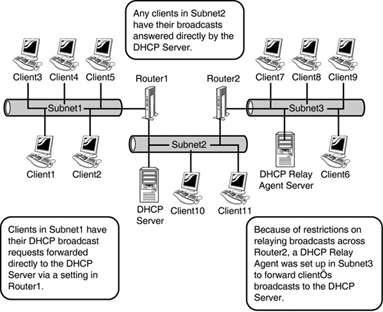The Dynamic Host Configuration Protocol (DHCP) In Depth
| The day-to-day operations of TCP/IP can be complex because clients must be able to receive and update their network information on a regular basis to keep in step with changes to a network. Each object in a TCP/IP environment requires a unique address that defines its location and provides for a means of routing network packets from place to place. This address, the IP address, must be assigned to each client in a network, to allow the clients to communicate using TCP/IP. In the past, most IP addresses were manually distributed as new clients were added to a network. This required a large amount of administrative overhead to maintain, and often resulted in problems in configuration caused by simple typographical errors and basic human error. An automatic method for distributing IP addresses to clients was subsequently sought because the administrative advantages of such a system were obvious. The search for such a system led to the predecessors of DHCP: RARP and BOOTP. The DHCP Client ServiceThe server portion of DHCP is only half of the equation in a DHCP transaction. The request for an IP address comes from a specific interface known as the DHCP client . The client is installed with TCP/IP in Windows 2000 and higher clients and can be installed as an additional component in down-level clients. The DHCP client, as previously mentioned, handles the communications with the DHCP Server service, in terms of handling IP requests and updates. Each iteration of the Windows client includes a different DHCP client, and there are slight variations in the functionality of each client; however, the overall functionto apply for and receive an IP address from a DHCP serverremains the same in each Windows client. Automatic Private IP Addressing (APIPA)The Client/Server service has been updated in Windows 2000 clients and later, enabling it to automatically assign itself an IP address if no server is available; it does so through a process called Automatic Private IP Addressing (APIPA). APIPA clients automatically assign themselves an IP address in the 169.254.0.0/16 range in this situation, which allows them to have basic TCP/IP connectivity in small networks. APIPA might be problematic in larger networks because it forces clients to assign themselves addresses in a range that is normally not part of a local company subnet. If a DHCP server is down, clients that are attempting to renew a lease with the server will fail and automatically assign themselves an APIPA address. When the server comes back online, they will not immediately re-register themselves and will effectively be cut off from the network. Subsequently, Microsoft supplies a Registry key that will disable APIPA in this situation. The key to be created is [View full width] HKLM\SYSTEM\CurrentControlSet\Services\Tcpip\Parameters\Interfaces\< AdapterName > You can create this key by following these steps on the client:
APIPA APIPA can also be effectively disabled in Windows XP clients through an alternative IP configuration, which allows for the designation of a static IP address if a DHCP is unavailable. DHCP Relay AgentsBecause DHCP clients use network broadcasts to seek out DHCP servers, it is important that this traffic is routed properly on a network with multiple subnets. Effectively, this means that there must be some type of agent to detect DHCP broadcast packets and forward them to the appropriate DHCP server, if it is located on another network. For Cisco routers, for example, this takes the form of an ip-helper entry in the router configuration that designates the destination IP address for broadcast packets to be forwarded to. If this entry is not used, a Windows server running the Routing and Remote Access service must be configured as a DHCP relay agent, as illustrated in Figure 13.23. Figure 13.23. DHCP broadcast packet routing. Include the Network Architecture Team in Any Discussions on DHCP Design In most real-world implementations of DHCP, the routers between network segments are configured to forward client DHCP broadcast packets directly to the DHCP server. In large organizations, it is therefore important to include the network architecture team in any discussions on DHCP design. DHCP and Dynamic DNSUsing the DNS Service in Windows Server 2003, clients can automatically register themselves in the DNS database through a mechanism called Dynamic DNS (DDNS). DHCP in Windows Server 2003 integrates directly with DDNS to provide for automatic registration of clients into DNS. By default, all Windows 2000 or later clients will perform this function by themselves, but DHCP can be configured to allow for the Server service to update the Dynamic DNS record for the client. This option can be turned on and off at the server level, through the DHCP Manager MMC. |
EAN: 2147483647
Pages: 325
